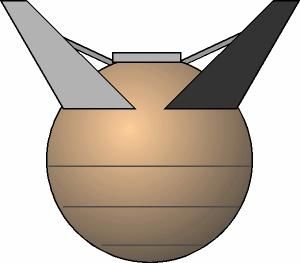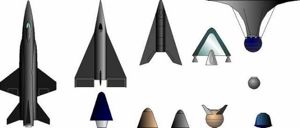
Home - Search - Browse - Alphabetic Index: 0- 1- 2- 3- 4- 5- 6- 7- 8- 9
A- B- C- D- E- F- G- H- I- J- K- L- M- N- O- P- Q- R- S- T- U- V- W- X- Y- Z
Goodyear Project 7969
 Proj 7969 Goodyear Credit: © Mark Wade |
Status: Study 1958. Gross mass: 900 kg (1,980 lb). Height: 2.13 m (6.98 ft).
Flaps were deflected from the cone during re-entry for increased drag and control.
The capsule would be launched by an Atlas or a Titan, plus a Vanguard upper stage into a 650 km orbit for a five day mission. Deorbit would be accomplished by a retrorocket providing a 240 m/sec braking impulse. An ablative heat shield was planned. In case of booster failure during ascent to orbit the capsule would be ejected. The spacecraft had a ballistic coefficient (W/CdA) of 250 kg per square meter. Landing precision was within a 1300 km diameter footprint. It was expected that a first manned orbital flight could be achieved 24 months after a go-ahead at a cost of $ 100 million.
Family: Manned spacecraft. Country: USA. Launch Vehicles: Titan, Titan-Vanguard. Agency: USAF, Goodyear. Bibliography: 26, 483, 59.
Back to top of page
Home - Search - Browse - Alphabetic Index: 0- 1- 2- 3- 4- 5- 6- 7- 8- 9
A- B- C- D- E- F- G- H- I- J- K- L- M- N- O- P- Q- R- S- T- U- V- W- X- Y- Z
© 1997-2019 Mark Wade - Contact
© / Conditions for Use
